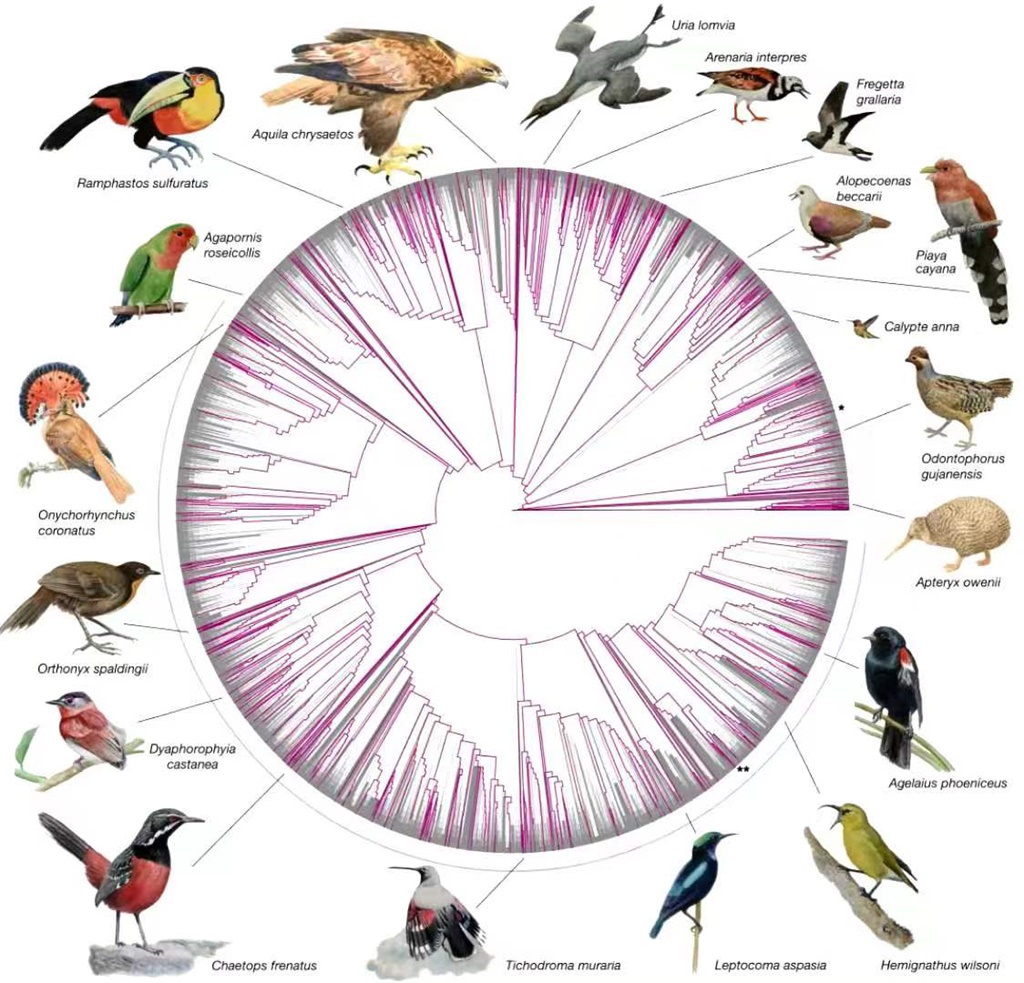A research consortium led by Prof. ZHANG Guojie from Kunming Institute of Zoology of the Chinese Academy of Sciences reported the genomes of for 363 bird species including 267 new genomes and illustrated how these resources give improved resolution on genomic evolution analyses. The finding was published in Nature on 12th November as cover story.
The Bird 10,000 Genome Project (B10K), an initiative to sequence the genomes of all living bird species, announces the completion of its second milestone—the release of genomes representing 92% of all bird families. This large international project is co-led by the Chinese Academy of Sciences, University of Copenhagen, China National Genebank at BGI-Shenzhen, the Smithsonian National Museum of Natural History, and Rockefeller University. In this study, the B10K achieved its family phase milestone releasing genomic resources for 363 bird species.
The paper established a new pipeline to analyze the unprecedented scale of genomic data, which revealed a detailed landscape of genomic sequence gains and losses across bird lineages. The study showed that the passerine birds, the largest extant order of bird species, possessed genomic features that differed from other bird groups. Passerine genomes also contain an additional copy of the growth hormone gene. The songbirds, a group of Passeriformes, have lost a gene called cornulin, which might have contributed to the evolution of their diverse pure-tone vocalizations. Dense genomic sampling also facilitated the detection of signals of natural selection down to the single-base level, which may not be possible with few genomes. “Such detection power was only possible when the species were densely represented in the comparative genomic analyses,” said Prof. ZHANG Guojie, an evolutionary biologist in Kunming Institute of Zoology and also University of Copenhagen. “These genomes allow us to explore the genomic variations among different bird groups and help to understand their diversification processes”.
The large collaborative effort involved over 150 researchers from 125 institutions in 24 countries. To sequence the bird genomes, the project heavily relies on tissue samples stored in museums around the globe. The Smithsonian National Museum of Natural History, the Natural History Museum of Denmark, and the Louisiana State University Museum of Natural Science contributed the majority of the samples for the project. This allowed them to sequence genomes from rare and endangered birds, which will be important resources for conservation actions. Gary Graves, curator of birds at the Smithsonian National Museum of Natural History in Washington D.C. emphasizes the central role of scientific collections for genomic studies, “This B10K milestone would not have been possible without the proactive support of natural history museums and their vast resources of carefully documented genetic specimens. The relevance of museums to studies of genomic evolution and the diversification of life on Earth has never been greater.”
This study, entitled “Dense sampling of bird diversity increases power of comparative genomics”, was published in Natureon 12th November as cover story. Web link: https://www.nature.com/articles/s41586-020-2873-9). Dr. Benedict Paten and Dr. ZHANG Guojie are the co-corresponding authors. This project was financially supported by grants from Strategic Priority Research Program of the Chinese Academy of Sciences (XDB31020000) and International Partnership Program of Chinese Academy of Sciences (no. 152453KYSB20170002).

Cover story. Image credit: SciStories

The newly-sequenced genomes densely cover the bird tree of life: the 10,135 bird species are shown on a draft phylogeny that synthesizes taxonomic and phylogenetic information; in total, 363 species, covering 92.4% of all families, now have at least one genome assembly per sequenced family (purple branches); the gray arc marks the diverse Passeriformes radiation, with 6,063 species, of which 173 species have genome assemblies now; chicken (*) and zebra finch (**) are marked for orientation.
(Image by Feng et al., doi: 10.1038/s41586-020-2873-9.)
(By ZHANG Guojieg, Editor: YANG Yingrun)
Contact:
YANG Yingrun
yangyingrun@mail.kiz.ac.cn
